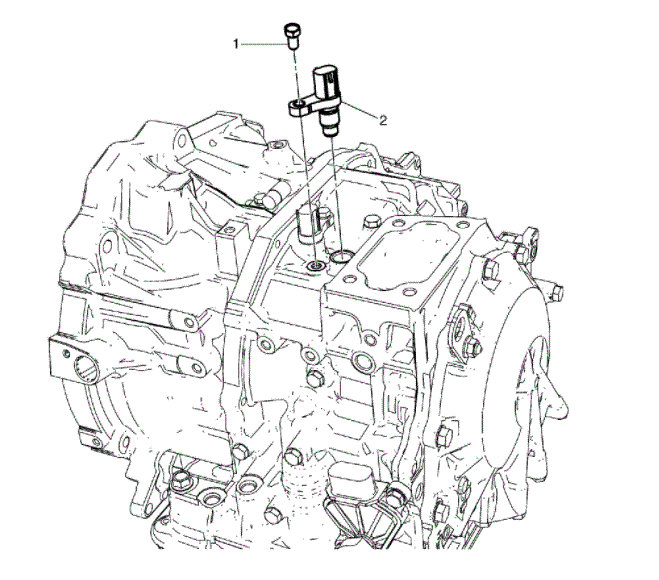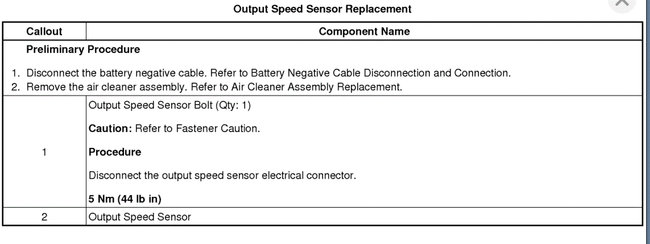Good evening,
The sensor is right on top of the transmission. I attached a picture and the procedure for you.
Please let me know how it works out.
Roy
Description for you of the code.
DTC P0722, P077C, or P077D
Diagnostic Instructions
Perform the Diagnostic System Check - Vehicle See: Vehicle > Initial Inspection and Diagnostic Overview > Diagnostic System Check - Vehicle prior to using this diagnostic procedure.
Review Strategy Based Diagnosis See: Vehicle > Initial Inspection and Diagnostic Overview > Strategy Based Diagnosis for an overview of the diagnostic approach.
Diagnostic Procedure Instructions See: Vehicle > Initial Inspection and Diagnostic Overview > Diagnostic Procedure Instructions provides an overview of each diagnostic category.
DTC Descriptors
DTC P0722
Output Speed Sensor Circuit No Signal
DTC P077C
Output Speed Sensor Circuit Low Voltage
DTC P077D
Output Speed Sensor Circuit High Voltage
Circuit/System Description
The output speed sensor (OSS) is installed in the transmission case. The OSS detects the revolution speed of the counter drive gear (4) as the output shaft speed. These signals are transmitted to the TCM. Based on those signals, the TCM controls engine torque, shift timing, and lock-up.
Conditions for Running the DTC
P0722
DTC P0705, P0706, P0717, P07C0, P07BF, P0748, P0778, P0798, P0962, P0963, P0966, P0967, P0970, P0971, P0973, or P0974 is not set.
The output speed is 300 RPM or greater.
The transmission is not in limp home mode.
The transmission range is D, 2, or L.
P077C
Ignition ON.
Battery voltage is between 10.2-18.0 volts.
P077D
Ignition ON.
Battery voltage is between 10.2-18.0 volts.
Conditions for Setting the DTC
P0722
The TCM detects no pulse signal from output speed sensor when there are 13 pulses from the input speed sensor, 500 occurrences.
P077C
Voltage signal is less than 0.2 V for 100 msec over 10 times.
P077D
Voltage signal is greater than 2.7 V for 100 msec over 10 times.
Action Taken When the DTC Sets
P0722
DTC P0722 is a Type A DTC.
The TCM allows the vehicle after below 10 km/h (6 mph) to be operated only in the fourth gear.
P077C and P077D
DTCs P077C and P077D are Type A DTCs.
The TCM allows the vehicle after below 10 km/h (6 mph) to be operated only in the second gear.
Conditions for Clearing the DTC
DTCs P0722, P077C, and P077D are Type A DTCs.
Reference Information
Schematic Reference
Automatic Transmission Controls Schematics See: Automatic Transmission/Transaxle > Electrical > Automatic Transmission Controls Schematics
Connector End View Reference
Component Connector End Views See: Vehicle > Connector Views > Fuel Pump and Level Sensor Assembly
Electrical Information Reference
Circuit Testing See: Vehicle > Component Tests and General Diagnostics > Circuit Testing
Connector Repairs See: Vehicle > Component Tests and General Diagnostics > Connector Repairs
Testing for Intermittent Conditions and Poor Connections See: Vehicle > Component Tests and General Diagnostics > Testing for Intermittent Conditions and Poor Connections
Wiring Repairs See: Vehicle > Component Tests and General Diagnostics > Wiring Repairs
DTC Type Reference
Powertrain Diagnostic Trouble Code (DTC) Type Definitions See: A L L Diagnostic Trouble Codes ( DTC ) > Diagnostic Trouble Code Descriptions > Powertrain Diagnostic Trouble Code (DTC) Type Definitions
Diagnostic Trouble Code (DTC) List - Vehicle See: A L L Diagnostic Trouble Codes ( DTC ) Diagnostic Trouble Code Descriptions > Diagnostic Trouble Code (DTC) List - Vehicle
Scan Tool Reference
Control Module References See: Vehicle > Programming and Relearning > Control Module References for scan information.
Circuit/System Verification
1. Operate the vehicle at 16-32 km/h (10-20 mph) while observing the scan tool Transmission OSS parameter. The Transmission OSS should vary with the vehicle speed and not drop out.
2. Operate the vehicle within the Conditions for Running the DTC to verify the DTC does not reset. You may also operate the vehicle within the conditions that you observe from the Freeze Frame/Failure Records data.
Circuit/System Testing
1. Ignition OFF, disconnect the output speed sensor wiring harness.
2. Ignition ON, Test for 9-12 volts between the high and low signal circuits, from TCM.
If not within the specified range, replace the K71 TCM.
3. If the circuits test normal, test or replace the B14A output speed sensor.
Component Testing
1. Test the output speed sensor wiring. There should not be an open, short to ground, or a short together condition.
If one of the above conditions is found, repair the circuit.
2. If all circuits test normal, replace the B14A output speed sensor.
Repair Instructions
Perform the Diagnostic Repair Verification See: A L L Diagnostic Trouble Codes ( DTC ) > Verification Tests > Diagnostic Repair Verification after completing the diagnostic procedure.
Output Speed Sensor Replacement See: Transmission Speed Sensor, A/T > Removal and Replacement > Output Speed Sensor Replacement
Transmission Adaptive Learn See: Automatic Transmission/Transaxle > Symptom Related Diagnostic Procedures > Transmission Adaptive Learn
Control Module References See: Vehicle > Programming and Relearning > Control Module References for TCM replacement, setup, and programming
Images (Click to make bigger)
Tuesday, September 1st, 2020 AT 3:20 PM




